- News
- Reviews
- Bikes
- Accessories
- Accessories - misc
- Computer mounts
- Bags
- Bar ends
- Bike bags & cases
- Bottle cages
- Bottles
- Cameras
- Car racks
- Child seats
- Computers
- Glasses
- GPS units
- Helmets
- Lights - front
- Lights - rear
- Lights - sets
- Locks
- Mirrors
- Mudguards
- Racks
- Pumps & CO2 inflators
- Puncture kits
- Reflectives
- Smart watches
- Stands and racks
- Trailers
- Clothing
- Components
- Bar tape & grips
- Bottom brackets
- Brake & gear cables
- Brake & STI levers
- Brake pads & spares
- Brakes
- Cassettes & freewheels
- Chains
- Chainsets & chainrings
- Derailleurs - front
- Derailleurs - rear
- Forks
- Gear levers & shifters
- Groupsets
- Handlebars & extensions
- Headsets
- Hubs
- Inner tubes
- Pedals
- Quick releases & skewers
- Saddles
- Seatposts
- Stems
- Wheels
- Tyres
- Health, fitness and nutrition
- Tools and workshop
- Miscellaneous
- Cross country mountain bikes
- Tubeless valves
- Buyers Guides
- Features
- Forum
- Recommends
- Podcast
review
£2,599.99
VERDICT:
Solid road bike with a slightly relaxed riding position, offering a good balance between performance and comfort
Weight:
8,010g
Contact:
At road.cc every product is thoroughly tested for as long as it takes to get a proper insight into how well it works. Our reviewers are experienced cyclists that we trust to be objective. While we strive to ensure that opinions expressed are backed up by facts, reviews are by their nature an informed opinion, not a definitive verdict. We don't intentionally try to break anything (except locks) but we do try to look for weak points in any design. The overall score is not just an average of the other scores: it reflects both a product's function and value – with value determined by how a product compares with items of similar spec, quality, and price.
What the road.cc scores meanGood scores are more common than bad, because fortunately good products are more common than bad.
- Exceptional
- Excellent
- Very Good
- Good
- Quite good
- Average
- Not so good
- Poor
- Bad
- Appalling
The Ghost Nivolet 6 LC is a Shimano Ultegra Di2-equipped road bike that splits the difference between racy and relaxed, a balance that will prove popular with many.
Pretty much every manufacturer likes to claim that their road bike is comfortable, even if it rides like a wrought-iron boneshaker, but the Nivolet 6 LC really is one of those bikes you can ride all day without feeling like you've taken a kicking from a horse.
Find your nearest dealer here
Buy this online here
The Ghost actually shares its carbon-fibre frame with the Lapierre Sensium 100 that we reviewed here on road.cc last year, the Ghost and Lapierre brands belonging to the same parent company.
The Nivolet's riding position is relaxed enough that you don't feel like you're constantly in an aggressive race mode, but it's not so upright that the whole idea of aerodynamic efficiency has been completely forgotten.
We talk a lot about riding position around these parts and that's because it's vitally important to a bike's character. Ghost describe the Nivolet's geometry as 'relaxed yet athletic' and that about sums it up. It's a performance-orientated setup but it's not as aggressive as some.
What does that actually mean? The Nivolet has a top tube that's a little shorter than you'd get with a traditional race geometry, and a head tube that's a little taller, but we're not talking massive differences.
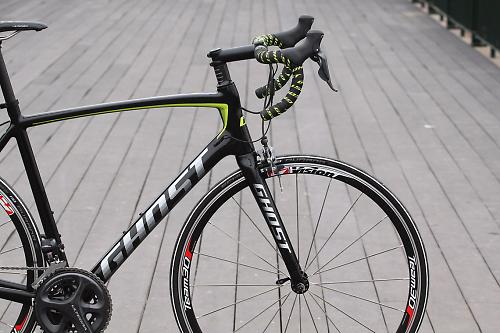
I've been riding the large sized model with a 550mm seat tube (bear in mind that the sloping top tube means the seat tube is shorter than it would otherwise be), a 565mm top tube and a 180mm head tube. The reach (the horizontal distance from the centre of the bottom bracket to the top of the head tube) is 385mm and the stack (the vertical distance between those points) is 575mm.
Our review bike came with a whopping 40mm of headset spacers and, not surprisingly, the riding position felt very upright when they were all positioned underneath the stem. You might like that high handlebar position but I moved the stem right down and found a setup that worked better for me; one with less air smacking me full in the chest but that was still sustainable for long hours in the saddle.
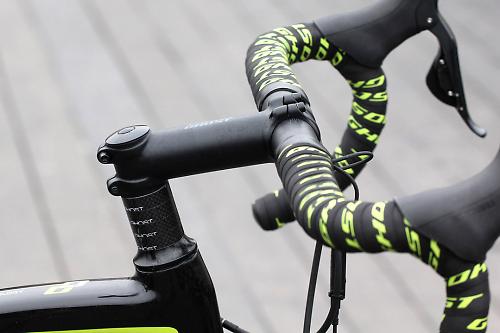
The Nivolet does a good job of neutralising road chatter so rough surfaces don't feel too jerky or jarring. The fairly skinny tubes at the back of the bike doubtless help in this respect, as does the full-carbon fork. I had a lot of the slim (27.2mm diameter) seatpost extending out of the frame too, allowing a bit more flex to cancel out vibration. The sloping top tube and short-for-the-size seat tube mean you're likely to have a similar situation. The spec sheet says that this Ghost has 25mm Schwalbe Durano tyres but ours actually came with 23s. I'd certainly swap to wider tyres when these wear out, for slightly more comfort with no loss of speed.

Saddles are always a matter of personal taste but the slightly curved Fizik Ardea specced here isn't likely to offend many. There's a generous amount of flex in its nylon carbon-reinforced shell and manganese rails, and quite a depth of padding. That adds together to provide a comfortable ride.
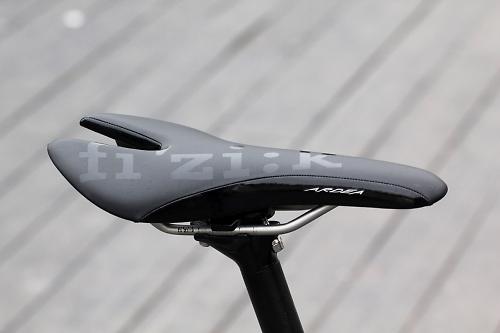
The Shimano Ultegra Di2 levers provide a well-shaped perch for your hands and their narrow diameter means it's easy to stay in full control when you're riding out of the saddle. I must say, though, I haven't got on especially well with Ghost's own aluminium handlebar. I like the straight section on the drops just behind the levers, but I'd prefer a longer sweep back at the ends. The slightly relaxed frame geometry meant I spent a lot of time down on the drops, and more of a rearward sweep would have given me another hand position there for those times on the flat when you just want to knuckle down and get some work done.
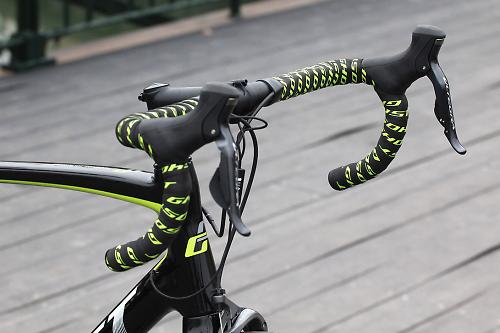
As I just mentioned, the Nivolet 6 LC comes fitted with Shimano Ultegra equipment, including Di2 electronic shifting. We have nothing but good to say about Ultegra Di2. The shifting is flawless front and rear in pretty much every situation – love it – and it's a whole lot cheaper than the pretty much indistinguishable Dura-Ace version. On the other hand, it's considerably more expensive than mechanical Ultegra.
My single criticism is that the upshift and downshift buttons are very close to one another. Although they're textured differently, I have occasionally found myself accidentally hitting the wrong one when wearing full finger gloves. Mind you, that's only an issue if you have the luxury of using Di2 year round.
Actually, I do have one other criticism. Ghost still use the external Di2 battery, positioning it underneath/behind the bottom bracket. It makes little difference from a practical point of view of function but an internal battery would look neater. Yes, I'm nit picking, but that's my job!
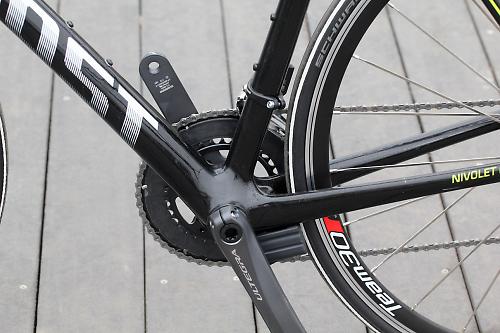
Many brands give you a couple of noticeable Ultegra components and sneak a few downgrades in under the radar, but Ghost have stuck with the programme pretty much throughout. As well as the shifters and mechs, the brakes are Ultegra and so is the chainset. The only deviation away from Ultegra is the next-level-down 105 cassette, and the difference there is negligible.
The chainset is a compact (with 50-tooth and 34-tooth chainrings) and the 11-speed cassette is 11-28. You probably already know whether you prefer a compact or a standard chainset. A compact is the right option for a whole lot of people, giving you lower gear ratios that might well come in handy – or perhaps be essential – when you hit the hills.


The Nivolet 6 LC is reasonably light at 8.01kg (17.6lb) and it puts in a solid if not a spectacular performance on the hills. Sit up with your hands on the tops of the handlebar and spin away in a low gear and you should ascend easily enough.
The flipside to the compact chainset is that you waive the highest gear ratios so you can't keep the pressure on for as long on fast descents, but you might want to use the opportunity to take a breather anyway. It comes down to the individual. If you do go for this bike and later on decide you'd prefer larger chainrings, swapping is relatively easy now that all of Shimano's chainsets use the same BCD (bolt circle diameter).
The Nivolet offers confidence-inspiring cornering. This is a bike you can chuck through tight bends knowing that you'll end up exactly where you want to. The tapered head tube and fork steerer (the lower bearing is 1 1/4in) must take the credit for that; there's very little flex even when you lean the bike over as far as you dare. Oh, and the Ultegra brakes are pukka if you do find you've overcooked it.
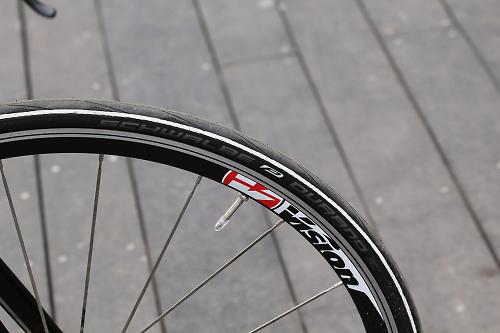
The only other major component I've not yet mentioned is the wheelset. The Nivolet comes with Vision Team 30 wheels that run very smoothly on their sealed cartridge bearings. They've stayed true throughout testing but they're outclassed by the frame and groupset. The 30mm-deep alloy rims contribute greatly to the 1,770g wheel weight. Don't get me wrong, they're okay wheels, but they're not exceptional on a £2,600 bike. It's a bike reviewing cliché to say that a particular model would perform better with higher-end wheels, but this one would! Drop some weight here and you'll certainly add some more zip to the bike.
The Ghost Nivolet 6 LC is not a bike of extremes. It offers a good balance between performance and comfort, with a geometry that's relaxed but not completely upright. It's reasonably light, but not mega-light. And it has a sporty feel without behaving like a full-on race bike. That's an appealing combination.
Verdict
Solid road bike with a slightly relaxed riding position, offering a good balance between performance and comfort
road.cc test report
Make and model: Ghost Nivolet 6 LC
Size tested: 57
About the bike
State the frame and fork material and method of construction. List the components used to build up the bike.
Frame Nivolet HM carbon ACR
Fork CG Carbon
Stem Ghost AS-025 31.8 mm
Handlebar Ghost420/440 mm 31.8 mm
Rear derailleur Shimano Ultegra Di2 11-Speed
Front derailleur Shimano Ultegra Di2
Shifters Shimano Ultegra Di2 SL
Chainset Shimano Ultegra 50-34
Cassette Shimano 105 11-28
Brakes Shimano Ultegra
Tyres Schwalbe Durano 25
Wheels FSA Vision Team 30
Seatpost Ghost light SP DC1 27.2 mm
Saddle Fizik Ardea
Tell us what the bike is for, and who it's aimed at. What do the manufacturers say about it? How does that compare to your own feelings about the bike?
It's a bike that strikes a balance somewhere between a traditional-style race bike and an endurance bike: a relaxed race bike, you might call it.
Frame and fork
Overall rating for frame and fork
8/10
Riding the bike
Rate the bike for efficiency of power transfer:
8/10
Rate the bike for acceleration:
7/10
Rate the bike for sprinting:
7/10
Rate the bike for high speed stability:
8/10
Rate the bike for cruising speed stability:
8/10
Rate the bike for low speed stability:
8/10
Rate the bike for flat cornering:
8/10
Rate the bike for cornering on descents:
8/10
Rate the bike for climbing:
7/10
The drivetrain
Rate the drivetrain for performance:
9/10
Rate the drivetrain for durability:
8/10
Rate the drivetrain for weight:
8/10
Rate the drivetrain for value:
8/10
Wheels and tyres
Rate the wheels and tyres for performance:
7/10
Rate the wheels and tyres for durability:
7/10
Rate the wheels and tyres for weight:
6/10
Rate the wheels and tyres for comfort:
7/10
Rate the wheels and tyres for value:
6/10
Controls
Rate the controls for performance:
9/10
Rate the controls for durability:
8/10
Rate the controls for weight:
8/10
Rate the controls for comfort:
9/10
Rate the controls for value:
7/10
Your summary
Did you enjoy riding the bike? Yes
Would you consider buying the bike? Hmm, not sure it does enough to grab my attention, despite the Di2 groupset
Would you recommend the bike to a friend? As above
Rate the bike overall for performance:
7/10
Rate the bike overall for value:
8/10
Anything further to say about the bike in conclusion?
There aren't all that many Shimano Ultegra Di2-equipped bikes around at this price unless you go for a direct-to-consumer brand, so that does certainly grab the attention. The same frame was excellent on the Lapierre Sensium that we reviewed last year, but that was a £1,250 bike. It's still a good frame on a bike twice that price, but it's not spectacular in this price band.
About the tester
Age: 43 Height: 190cm Weight: 75kg
I usually ride: My best bike is:
I've been riding for: Over 20 years I ride: Most days I would class myself as: Expert
I regularly do the following types of riding: commuting, club rides, sportives, general fitness riding
Mat has been in cycling media since 1996, on titles including BikeRadar, Total Bike, Total Mountain Bike, What Mountain Bike and Mountain Biking UK, and he has been editor of 220 Triathlon and Cycling Plus. Mat has been road.cc technical editor for over a decade, testing bikes, fettling the latest kit, and trying out the most up-to-the-minute clothing. He has won his category in Ironman UK 70.3 and finished on the podium in both marathons he has run. Mat is a Cambridge graduate who did a post-grad in magazine journalism, and he is a winner of the Cycling Media Award for Specialist Online Writer. Now over 50, he's riding road and gravel bikes most days for fun and fitness rather than training for competitions.





























One wonders if you really are this obtuse or simply being vexatious, like the naughty child at the back of the class who can only get the...
So you accept that households suffer from motor traffic? Well, it's a start. ...
What comes after the post-truth age? The utter nonsense age, apparently. These are just a few examples, and I got bored with shooting fish in a...
Exactly what I said previously. Stop making a fool of yourself.
Herein lies difference between cyclist and just people that happen to ride bikes. If it did happen, the person riding the bike wasn't a cyclist,...
No, there are not. Not even close to that many involving vehicular killings by small-town cops....
That's nearly as bad as 'wall crashed into car'.
I think you need to flip the page in your Roget. The one you're on doesn't seem to fill you with Joie de vivre. Think grey and all you'll get is...
Bit reminiscent of the MTB world Jones bar. About the same price, too!
Well I was inspired by this discussion to try a 20 minute FTP test on Zwift yesterday and found to my surprise that according to it I'm not the 195...